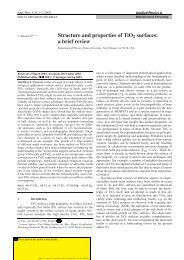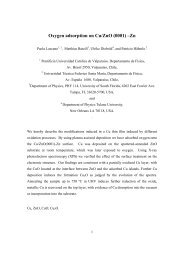The surface science of titanium dioxide - Niser
The surface science of titanium dioxide - Niser
The surface science of titanium dioxide - Niser
You also want an ePaper? Increase the reach of your titles
YUMPU automatically turns print PDFs into web optimized ePapers that Google loves.
82 U. Diebold / Surface Science Reports 48 (2003) 53±229<br />
Fig. 14. STM image …200 Ð 200 І <strong>of</strong> a TiO 2 (1 1 0) <strong>surface</strong>, sputtered and annealed in UHV to 1100 K for 10 min,<br />
showing point defects. Features labeled with `A' have been assigned as oxygen vacancies. <strong>The</strong> position <strong>of</strong> the line scan shown<br />
is indicated in the image. From [116].<br />
vacancydensityestimates from spectroscopic measurements. <strong>The</strong> size <strong>of</strong> the bright spots is <strong>of</strong> the order<br />
<strong>of</strong> one single atom (FWHM 5 AÊ in line scans along the [0 0 1] direction) when taking into account<br />
convolution with the tip. <strong>The</strong>yalways appear as isolated spots with no apparent short-range ordering<br />
but a slight tendencyto be staggered perpendicular to the rows. It is well-known that oxygen vacancies<br />
are healed bydosing a reduced TiO 2 sample with oxygen [127,130,131]. When the sample in Fig. 14<br />
was stepwise exposed to oxygen, the density <strong>of</strong> the bright spots (A) decreased. This, and the contrast<br />
expected from electronic structure calculations (missing bridging oxygens give rise to a protrusion in<br />
empty-states charge-density contours, see Fig. 9b) led to the assumption <strong>of</strong> the bright spots being<br />
missing oxygen vacancies [110,116]. As was reported in [116], their appearance in STM is stronglytipdependent.<br />
<strong>The</strong> dark features (B in Fig. 14) are less common (<strong>surface</strong> concentration <strong>of</strong> 1±2%) than the oxygen<br />
vacancies. <strong>The</strong>ycan extend over several unit cells. Upon adsorption <strong>of</strong> oxygen, the number <strong>of</strong> the dark<br />
spots stays constant within the statistical error. <strong>The</strong>y were tentatively assigned as sub<strong>surface</strong> oxygen<br />
vacancies [109], however, ®rst-principles total-energycalculations show that such a con®guration is<br />
highlyunlikely[132]. <strong>The</strong>ir nature is unclear at this point.<br />
<strong>The</strong> `A' features, assigned to oxygen vacancies in Fig. 14, are mobile in STM images, albeit in a<br />
somewhat erratic fashion [116]. <strong>The</strong>ycan be removed byscanning with a high bias voltage [116,133],<br />
hence one needs to consider that theyrepresent adsorbates, speci®callyH atoms adsorbed on a bridging<br />
O atom. In [116] this possibilitywas discarded because the density<strong>of</strong> these features decreases upon<br />
exposure to molecular oxygen, as expected for a `®lling' <strong>of</strong> vacancies, and because they could not be<br />
¯ashed <strong>of</strong>f. Suzuki et al. [133], however, argued that these features represent H atoms on bridging<br />
oxygen atoms because their number density decreases upon irradiation with 20 eV-electrons and<br />
increases upon exposure <strong>of</strong> the <strong>surface</strong> to atomic hydrogen. A few `A' features were resistant against<br />
irradiation with electrons and were attributed to H atoms trapped on an oxygen vacancy. <strong>The</strong>se authors<br />
concluded that H adatoms, either on bridging oxygen atoms or on O vacancies, still exist on TiO 2 (1 1 0)<br />
when <strong>surface</strong>s were prepared bysputtering and annealing. <strong>The</strong> H was supposed to stem from the bulk.<br />
Recent STM <strong>of</strong> clean and water-covered <strong>surface</strong>s showed that oxygen vacancies and hydroxylated<br />
bridging oxygen atoms are imaged slightly different in STM images [134], see Fig. 15. <strong>The</strong> main







